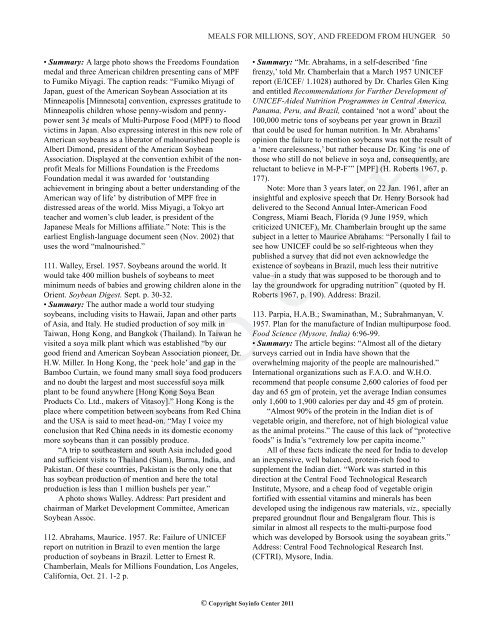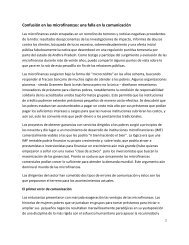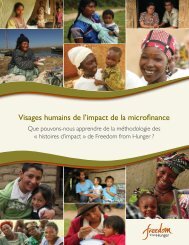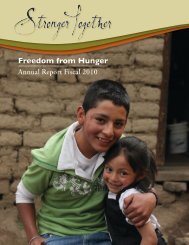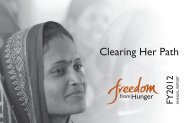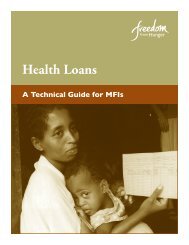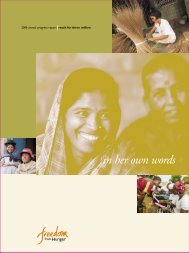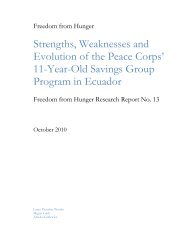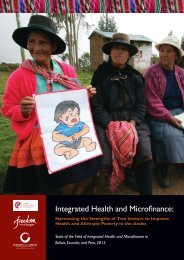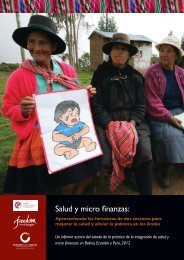history of meals for millions, soy, and freedom from ... - SoyInfo Center
history of meals for millions, soy, and freedom from ... - SoyInfo Center
history of meals for millions, soy, and freedom from ... - SoyInfo Center
You also want an ePaper? Increase the reach of your titles
YUMPU automatically turns print PDFs into web optimized ePapers that Google loves.
• Summary: A large photo shows the Freedoms Foundation<br />
medal <strong>and</strong> three American children presenting cans <strong>of</strong> MPF<br />
to Fumiko Miyagi. The caption reads: “Fumiko Miyagi <strong>of</strong><br />
Japan, guest <strong>of</strong> the American Soybean Association at its<br />
Minneapolis [Minnesota] convention, expresses gratitude to<br />
Minneapolis children whose penny-wisdom <strong>and</strong> pennypower<br />
sent 3¢ <strong>meals</strong> <strong>of</strong> Multi-Purpose Food (MPF) to flood<br />
victims in Japan. Also expressing interest in this new role <strong>of</strong><br />
American <strong>soy</strong>beans as a liberator <strong>of</strong> malnourished people is<br />
Albert Dimond, president <strong>of</strong> the American Soybean<br />
Association. Displayed at the convention exhibit <strong>of</strong> the nonpr<strong>of</strong>it<br />
Meals <strong>for</strong> Millions Foundation is the Freedoms<br />
Foundation medal it was awarded <strong>for</strong> ‘outst<strong>and</strong>ing<br />
achievement in bringing about a better underst<strong>and</strong>ing <strong>of</strong> the<br />
American way <strong>of</strong> life’ by distribution <strong>of</strong> MPF free in<br />
distressed areas <strong>of</strong> the world. Miss Miyagi, a Tokyo art<br />
teacher <strong>and</strong> women’s club leader, is president <strong>of</strong> the<br />
Japanese Meals <strong>for</strong> Millions affiliate.” Note: This is the<br />
earliest English-language document seen (Nov. 2002) that<br />
uses the word “malnourished.”<br />
111. Walley, Ersel. 1957. Soybeans around the world. It<br />
would take 400 million bushels <strong>of</strong> <strong>soy</strong>beans to meet<br />
minimum needs <strong>of</strong> babies <strong>and</strong> growing children alone in the<br />
Orient. Soybean Digest. Sept. p. 30-32.<br />
• Summary: The author made a world tour studying<br />
<strong>soy</strong>beans, including visits to Hawaii, Japan <strong>and</strong> other parts<br />
<strong>of</strong> Asia, <strong>and</strong> Italy. He studied production <strong>of</strong> <strong>soy</strong> milk in<br />
Taiwan, Hong Kong, <strong>and</strong> Bangkok (Thail<strong>and</strong>). In Taiwan he<br />
visited a <strong>soy</strong>a milk plant which was established “by our<br />
good friend <strong>and</strong> American Soybean Association pioneer, Dr.<br />
H.W. Miller. In Hong Kong, the ‘peek hole’ <strong>and</strong> gap in the<br />
Bamboo Curtain, we found many small <strong>soy</strong>a food producers<br />
<strong>and</strong> no doubt the largest <strong>and</strong> most successful <strong>soy</strong>a milk<br />
plant to be found anywhere [Hong Kong Soya Bean<br />
Products Co. Ltd., makers <strong>of</strong> Vita<strong>soy</strong>].” Hong Kong is the<br />
place where competition between <strong>soy</strong>beans <strong>from</strong> Red China<br />
<strong>and</strong> the USA is said to meet head-on. “May I voice my<br />
conclusion that Red China needs in its domestic economy<br />
more <strong>soy</strong>beans than it can possibly produce.<br />
“A trip to southeastern <strong>and</strong> south Asia included good<br />
<strong>and</strong> sufficient visits to Thail<strong>and</strong> (Siam), Burma, India, <strong>and</strong><br />
Pakistan. Of these countries, Pakistan is the only one that<br />
has <strong>soy</strong>bean production <strong>of</strong> mention <strong>and</strong> here the total<br />
production is less than 1 million bushels per year.”<br />
A photo shows Walley. Address: Part president <strong>and</strong><br />
chairman <strong>of</strong> Market Development Committee, American<br />
Soybean Assoc.<br />
112. Abrahams, Maurice. 1957. Re: Failure <strong>of</strong> UNICEF<br />
report on nutrition in Brazil to even mention the large<br />
production <strong>of</strong> <strong>soy</strong>beans in Brazil. Letter to Ernest R.<br />
Chamberlain, Meals <strong>for</strong> Millions Foundation, Los Angeles,<br />
Cali<strong>for</strong>nia, Oct. 21. 1-2 p.<br />
MEALS FOR MILLIONS, SOY, AND FREEDOM FROM HUNGER 50<br />
© Copyright Soyinfo <strong>Center</strong> 2011<br />
• Summary: “Mr. Abrahams, in a self-described ‘fine<br />
frenzy,’ told Mr. Chamberlain that a March 1957 UNICEF<br />
report (E/ICEF/ 1.1028) authored by Dr. Charles Glen King<br />
<strong>and</strong> entitled Recommendations <strong>for</strong> Further Development <strong>of</strong><br />
UNICEF-Aided Nutrition Programmes in Central America,<br />
Panama, Peru, <strong>and</strong> Brazil, contained ‘not a word’ about the<br />
100,000 metric tons <strong>of</strong> <strong>soy</strong>beans per year grown in Brazil<br />
that could be used <strong>for</strong> human nutrition. In Mr. Abrahams’<br />
opinion the failure to mention <strong>soy</strong>beans was not the result <strong>of</strong><br />
a ‘mere carelessness,’ but rather because Dr. King ‘is one <strong>of</strong><br />
those who still do not believe in <strong>soy</strong>a <strong>and</strong>, consequently, are<br />
reluctant to believe in M-P-F’” [MPF] (H. Roberts 1967, p.<br />
177).<br />
Note: More than 3 years later, on 22 Jan. 1961, after an<br />
insightful <strong>and</strong> explosive speech that Dr. Henry Borsook had<br />
delivered to the Second Annual Inter-American Food<br />
Congress, Miami Beach, Florida (9 June 1959, which<br />
criticized UNICEF), Mr. Chamberlain brought up the same<br />
subject in a letter to Maurice Abrahams: “Personally I fail to<br />
see how UNICEF could be so self-righteous when they<br />
published a survey that did not even acknowledge the<br />
existence <strong>of</strong> <strong>soy</strong>beans in Brazil, much less their nutritive<br />
value–in a study that was supposed to be thorough <strong>and</strong> to<br />
lay the groundwork <strong>for</strong> upgrading nutrition” (quoted by H.<br />
Roberts 1967, p. 190). Address: Brazil.<br />
113. Parpia, H.A.B.; Swaminathan, M.; Subrahmanyan, V.<br />
1957. Plan <strong>for</strong> the manufacture <strong>of</strong> Indian multipurpose food.<br />
Food Science (Mysore, India) 6:96-99.<br />
• Summary: The article begins: “Almost all <strong>of</strong> the dietary<br />
surveys carried out in India have shown that the<br />
overwhelming majority <strong>of</strong> the people are malnourished.”<br />
International organizations such as F.A.O. <strong>and</strong> W.H.O.<br />
recommend that people consume 2,600 calories <strong>of</strong> food per<br />
day <strong>and</strong> 65 gm <strong>of</strong> protein, yet the average Indian consumes<br />
only 1,600 to 1,900 calories per day <strong>and</strong> 45 gm <strong>of</strong> protein.<br />
“Almost 90% <strong>of</strong> the protein in the Indian diet is <strong>of</strong><br />
vegetable origin, <strong>and</strong> there<strong>for</strong>e, not <strong>of</strong> high biological value<br />
as the animal proteins.” The cause <strong>of</strong> this lack <strong>of</strong> “protective<br />
foods” is India’s “extremely low per capita income.”<br />
All <strong>of</strong> these facts indicate the need <strong>for</strong> India to develop<br />
an inexpensive, well balanced, protein-rich food to<br />
supplement the Indian diet. “Work was started in this<br />
direction at the Central Food Technological Research<br />
Institute, Mysore, <strong>and</strong> a cheap food <strong>of</strong> vegetable origin<br />
<strong>for</strong>tified with essential vitamins <strong>and</strong> minerals has been<br />
developed using the indigenous raw materials, viz., specially<br />
prepared groundnut flour <strong>and</strong> Bengalgram flour. This is<br />
similar in almost all respects to the multi-purpose food<br />
which was developed by Borsook using the <strong>soy</strong>abean grits.”<br />
Address: Central Food Technological Research Inst.<br />
(CFTRI), Mysore, India.


